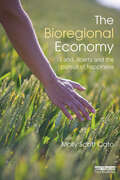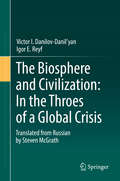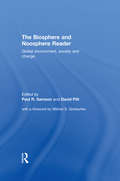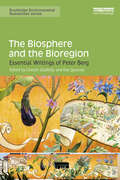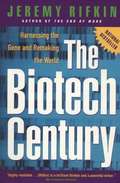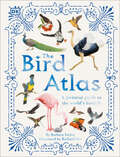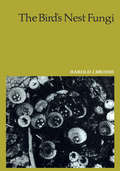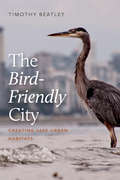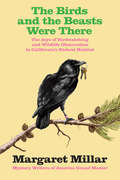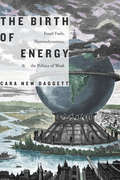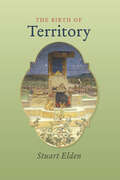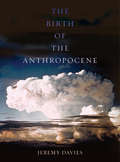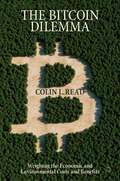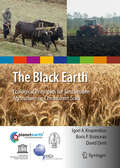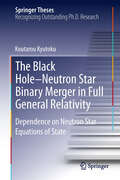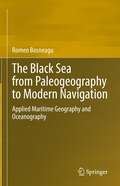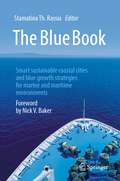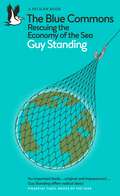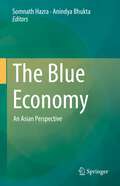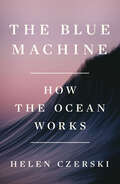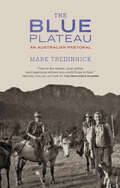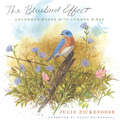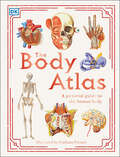- Table View
- List View
The Bioregional Economy: Land, Liberty and the Pursuit of Happiness
by Molly Scott CatoIn a world of climate change and declining oil supplies, what is the plan for the provisioning of resources? Green economists suggest a need to replace the globalised economy, and its extended supply chains, with a more ‘local’ economy. But what does this mean in more concrete terms? How large is a local economy, how self-reliant can it be, and what resources will still need to be imported? The concept of the ‘bioregion’ — developed and popularised within the disciplines of earth sciences, biosciences and planning — may facilitate the reconceptualisation of the global economy as a system of largely self-sufficient local economies. A bioregional approach to economics assumes a different system of values to that which dominates neoclassical economics. The global economy is driven by growth, and the consumption ethic that matches this is one of expansion in range and quantity. Goods are defined as scarce, and access to them is a process based on competition. The bioregional approach challenges every aspect of that value system. It seeks a new ethic of consumption that prioritises locality, accountability and conviviality in the place of expansion and profit; it proposes a shift in the focus of the economy away from profits and towards provisioning; and it assumes a radical reorientation of work from employment towards livelihood. This book by leading green economist Molly Scott Cato sets out a visionary and yet rigorous account of what a bioregional approach to the economy would mean — and how to get there from here.
The Biosphere and Civilization: In the Throes of a Global Crisis
by Victor I. Danilov-Danil'yan Igor E. ReyfThis monograph explores the dire ecological, social, and economic situations facing mankind through comprehensive analyses of global ecological issues, poverty, environmental stability and regulation, and sustainable development. Drs. Victor Danilov-Danil’yan and Igor Reyf discuss the development of ecology as a science, the increasing concern among scientists and public servants for the unsustainability of current economic and demographic trends, and the dire consequences our planet and civilization are already suffering as a result of the ongoing environmental and social crisis. They also address the philosophical implications of the crisis, and suggest possible solutions. The book conveys complex objects of study, namely the biosphere and the harmful anthropogenic processes it has been experiencing for decades, so that the work is accessible without omitting key components of the subject matter. Readers will learn about the social and economic contributors to a threatened biosphere, the mechanisms that maintain the stability of the global environment, and the scales at which sustainable development and preservation can be applied to initiate environmental regulation. Though intended to appeal to the general public and non-specialists, environmental researchers, organizations involved in sustainable development and conservation, and students engaged in ecology, environment, and sustainability studies will also find this book of interest.
The Biosphere and Noosphere Reader: Global Environment, Society and Change
by David Pitt Paul R. SamsonThe Reader is the first comprehensive history of the noosphere and biosphere. Drawing on classical influences, modern parallels, and insights into the future, the Reader traces the emergence of noosphere and biosphere concepts within the concept of environmental change. Reproducing material from seminla works, both past and present, key ideas and writings of prominent thinkers are presented, including Bergson, Vernadsky, Lovelock, Russell, Needham, Huxley, Medawar, Toynbee and Boulding, and extensive introductory pieces bu the editors drawattention to common themes and competing ideas. Focussing on issues of origins, theories, parallels and potential, the discussions place issues in a broad context, compare and contrast central concepts with those of the Gaia hypothesis, sustainability and global change, and examine the potential application of noospheric ideas to current debates about culture, education and technology in such realms as the Internet, space exploration, and the emergence of super-consciousness. Literally the `sphere of mind or intellect', the noosphere is aprt of the `realm of the possible' in human affairs, where there is a conscious effort to tackle global issues The noosphere concept captures a number of key contemporary issues - social evolution, global ecology, Gaia, deep ecology and global environmental change - contributing to ongoing debates concerning the implications of emerging technologies.
The Biosphere and the Bioregion: Essential Writings of Peter Berg (Routledge Environmental Humanities)
by Cheryll Glotfelty Eve QuesnelBioregionalism asks us to reimagine ourselves and the places where we live in ecological terms and to harmonize human activities with the natural systems that sustain life. As one of the originators of the concept of bioregionalism, Peter Berg (1937-2011) is a founding figure of contemporary environmental thought. The Biosphere and the Bioregion: Essential Writings of Peter Berg introduces readers to the biospheric vision and post-environmental genius of Berg. From books and essays to published interviews, this selection of writings represents Berg's bioregional vision and its global, local, urban, and rural applications. The Biosphere and the Bioregion provides a highly accessible introduction to bioregional philosophy, making Berg's paradigm available as a guiding vision and practical "greenprint" for the twenty-first century. This valuable compilation lays the groundwork for future research by offering the first-ever comprehensive bibliography of Berg's publications and should be of interest to students and scholars in the interdisciplinary fields of environmental humanities, environment and sustainability studies, as well as political ecology, environmental sociology and anthropology.
The Biotech Century: Harnessing the Gene and Remaking the World
by Jeremy RifkinIn this seminal book, Jeremy Rifkin explores the epic marriage between computer technology and genetic engineering, and the historic transition into the Age of Biotechnology. Already, Rifkin explains, our economy is undergoing a massive shift away from the Industrial Age and into an era in which giant life-science corporations are fashioning a bioindustrial world. Humanity is on the brink of wielding greater control over the shape of life--how we are born; how our food supply is created; the traits our children may have--than has ever been imagined. But with each step into this new era, we must ask ourselves: At what cost?
The Bird Atlas (DK Pictorial Atlases)
by Barbara TaylorTake a peek inside the beautiful and absorbing world of birds with this lavishly illustrated children&’s bird atlas.From the Amazon Rainforest to the Rocky Mountains, this fully-fledged children&’s bird guide will take you on a guided tour, continent by continent, to meet some of the most spectacular birds in the world! Get ready to journey through different biomes, like rivers and desserts, to discover fun facts about birds that will fascinate and inspire every budding ornithologist. In this bird book for kids, you&’ll learn why flamingos are pink, why birds migrate and who migrates the farthest, and which bird species are endangered.Packed with hundreds of incredible, life-like illustrations, this educational book is a pictorial guide to the birds of the world. It showcases birds from every continent as you&’ve never seen before with detailed maps pinpointing where different species of birds can be found. See magnificent snowy owls in the Arctic, tiny three-wattled bellbirds in the Caribbean, towering ostriches in Africa, and gorgeous depictions of the flighty American Robin. A Truly Breathtaking Celebration of BirdlifeThe Bird Atlas is arranged in order of continent - Europe, Asia, Africa, Australasia, North America, South America, and Antarctica. Every continent is introduced with an overview of the ecology, climate, and landscape, and the typical and incredible birds that live there. This children&’s book is the perfect introduction to our feathered friends and makes a great gift for the new generation of birdwatchers.Inside the pages of this children&’s atlas, you&’ll discover: • Fascinating facts about birds, from why vultures are bald to how bald eagles actually aren&’t • Why some species are endangered and what can be done to protect them • Birds that can be found in different countries and continents of the world, their habitat, geography, and climate More from DK Books:Don&’t miss out on more fascinating atlases! After exploring this fascinating bird book for kids, your child can move on to The Body Atlas to discover the inner workings of the human body. Next up is The Animal Atlas that takes children on a tour to meet the animals of the world.
The Bird's Nest Fungi
by Harold J. BrodieThe intriguing Bird's Nest Fungi (Nidulariaceae) of forest, meadow, and garden have been familiar to botanists since 1601, but only relatively recently has the significance of their peculiar form been realized. Dr Brodie traces the long controversy that arose when Bird's Nest Fungi were first classified as seed plants because of the numerous seed-like bodies contained in their small cup-shaped fruit bodies. The 'seeds' are now known to contain spores like those of other fungi such as puffballs, to which the Nidulariaceae are related. Present-day research has shown that certain Bird's Nest Fungi produce chemicals having previously unrecognized molecular structure. Between these milestones Dr Brodie reveals the solution to the mystery of the dispersal of the 'eggs' from the 'bird's nest': the fruit bodies are splash guns from which the reproductive spores are ejected by the force of falling raindrops. This explanation of the phenomenon is supported by copious observations and hitherto unpublished experiments.All known species of Nidulariaceae, including many only recently recognized, are described in this volume. All aspects of growth, structure, development, and life-cycle of these fungi, both in nature and in laboratory culture, are reported in a modern, comprehensive treatment of a subject which is of interest not only to mycologists but to amateur naturalists as well.
The Bird-Friendly City: Creating Safe Urban Habitats
by Timothy BeatleyHow does a bird experience a city? A backyard? A park? As the world has become more urban, noisier from increased traffic, and brighter from streetlights and office buildings, it has also become more dangerous for countless species of birds. Warblers become disoriented by nighttime lights and collide with buildings. Ground-feeding sparrows fall prey to feral cats. Hawks and other birds-of-prey are sickened by rat poison. These name just a few of the myriad hazards. How do our cities need to change in order to reduce the threats, often created unintentionally, that have resulted in nearly three billion birds lost in North America alone since the 1970s? In The Bird-Friendly City, Timothy Beatley, a longtime advocate for intertwining the built and natural environments, takes readers on a global tour of cities that are reinventing the status quo with birds in mind. Efforts span a fascinating breadth of approaches: public education, urban planning and design, habitat restoration, architecture, art, civil disobedience, and more. Beatley shares empowering examples, including: advocates for "catios,&” enclosed outdoor spaces that allow cats to enjoy backyards without being able to catch birds; a public relations campaign for vultures; and innovations in building design that balance aesthetics with preventing bird strikes. Through these changes and the others Beatley describes, it is possible to make our urban environments more welcoming to many bird species. Readers will come away motivated to implement and advocate for bird-friendly changes, with inspiring examples to draw from. Whether birds are migrating and need a temporary shelter or are taking up permanent residence in a backyard, when the environment is safer for birds, humans are happier as well.
The Birds and the Beasts Were There: The Joys of Birdwatching and Wildlife Observation in California's Richest Habitat
by Margaret MillarSanta Barbara in the 1960s was home to two of the 20th century’s most important mystery writers, Margaret Millar and her husband, Ken (Ross Macdonald). It was also home to nearly 400 species of bird. This is the charming story of Ken and Maggie’s quest to see them all. The addiction that is birdwatching comes to vivid life in Margaret Millar’s delightful memoir of her early days as a naturalist. Part autobiography and part birdwatcher’s journal, it is a moving elegy to a bygone place and time. Millar brings her meticulous plotting and no small amount of suspense to these charming stories of a belligerent brown towhee named Houdunit, a larcenous raven called Melanie, and a rat who carefully ferments his grapes before eating them, to name only a few. Ornithology was a passion for both Ken and Maggie and they devoted their lives to it with the same keen sense of detail and, in the case of Margaret, storytelling vigor as they brought to their writing. In this book, the only memoir she wrote, Millar takes us on her journey from curious amateur to obsessive completionist. It is a phenomenon nearly any birding enthusiast will recognize. Ken and Margaret Millar were founding members of the Santa Barbara Audubon Society.
The Birth of Energy: Fossil Fuels, Thermodynamics, and the Politics of Work (Elements)
by Cara New DaggettIn The Birth of Energy Cara New Daggett traces the genealogy of contemporary notions of energy back to the nineteenth-century science of thermodynamics to challenge the underlying logic that informs today's uses of energy. These early resource-based concepts of power first emerged during the Industrial Revolution and were tightly bound to Western capitalist domination and the politics of industrialized work. As Daggett shows, thermodynamics was deployed as an imperial science to govern fossil fuel use, labor, and colonial expansion, in part through a hierarchical ordering of humans and nonhumans. By systematically excavating the historical connection between energy and work, Daggett argues that only by transforming the politics of work—most notably, the veneration of waged work—will we be able to confront the Anthropocene's energy problem. Substituting one source of energy for another will not ensure a habitable planet; rather, the concepts of energy and work themselves must be decoupled.
The Birth of Territory
by Stuart EldenPolitical theory professor Stuart Elden explores the history of land ownership and control from the ancient to the modern world in The Birth of Territory.Territory is one of the central political concepts of the modern world and, indeed, functions as the primary way the world is divided and controlled politically. Yet territory has not received the critical attention afforded to other crucial concepts such as sovereignty, rights, and justice. While territory continues to matter politically, and territorial disputes and arrangements are studied in detail, the concept of territory itself is often neglected today. Where did the idea of exclusive ownership of a portion of the earth’s surface come from, and what kinds of complexities are hidden behind that seemingly straightforward definition? The Birth of Territory provides a detailed account of the emergence of territory within Western political thought. Looking at ancient, medieval, Renaissance, and early modern thought, Stuart Elden examines the evolution of the concept of territory from ancient Greece to the seventeenth century to determine how we arrived at our contemporary understanding. Elden addresses a range of historical, political, and literary texts and practices, as well as a number of key players—historians, poets, philosophers, theologians, and secular political theorists—and in doing so sheds new light on the way the world came to be ordered and how the earth’s surface is divided, controlled, and administered.“The Birth of Territory is an outstanding scholarly achievement . . . a book that already promises to become a ‘classic’ in geography, together with very few others published in the past decades.” —Political Geography“An impressive feat of erudition.” —American Historical Review
The Birth of the Anthropocene
by Jeremy DaviesThe world faces an environmental crisis unprecedented in human history. Carbon dioxide levels have reached heights not seen for three million years, and the greatest mass extinction since the time of the dinosaurs appears to be underway. Such far-reaching changes suggest something remarkable: the beginning of a new geological epoch. It has been called the Anthropocene. The Birth of the Anthropocene shows how this epochal transformation puts the deep history of the planet at the heart of contemporary environmental politics. By opening a window onto geological time, the idea of the Anthropocene changes our understanding of present-day environmental destruction and injustice. Linking new developments in earth science to the insights of world historians, Jeremy Davies shows that as the Anthropocene epoch begins, politics and geology have become inextricably entwined.
The Bitcoin Dilemma: Weighing the Economic and Environmental Costs and Benefits
by Colin L. ReadThere are few innovations that have the potential to revolutionize commerce and have evolved so quickly that there remain significant misunderstandings about their operation, opportunity, and challenges as has Bitcoin in the dozen years since its invention. The potential for banking, transacting, and public recording of important records is profound, but can be displacing if not done with appropriate care, and is downright dangerous if certain pitfalls are not noted and avoided. Among other things, this book proves the existence of a Bitcoin dilemma that challenges the conventional wisdom which mistakenly asserts the incredibly intensive energy consumption in Proof-of-Work cryptocurrency mining will be remedied by more efficient mining machines or sustainable power sources. It shows for the first time within a well-specified economic model of Bitcoin mining that the recent runup in electricity consumption has a simple and inevitable explanation. For a coin with almost completely inelastic supply and steadily increasing demand, the conditions for accelerating electricity demand is consistent with economic theory and may well characterize the future of Bitcoin. The book also demonstrates the counterintuitive result that improvements in mining efficiency, in terms of electricity consumption per terahash of processing power, or decreases in electricity costs as cheaper sustainable energy is diverted to this industry, merely exacerbates the acceleration of energy consumption because of a prisoner’s dilemma arms-race-to-the-bottom. The book proposes policy solutions to mitigate this Bitcoin dilemma but note that the mobility of industry capacity which needs but a ready supply of electricity and an Internet connection frustrates local regulation and warrants global solutions. The incredible opportunities of this industry will only be realized if our regulators, legislators, entrepreneurs, and general public garner a more complete and objective understanding of this and other Proof-of-Work mining techniques. The book provides this broader perspective based on the author’s research as an economist, his position as a director of a large regional bank, his understanding as a technologist and as an environmental and sustainability researcher, and his public policy experience as a mayor who has also written books and articles about public policy and public finance.
The Black Earth
by David Dent Igori Arcadie Krupenikov Boris P BoinceanSoil is the Earth's living skin. It provides anchorage for roots, holds water long enough for plants to make use of it and the nutrients that sustain life - otherwise the Earth would be as barren as Mars. It is home to myriad micro-organisms and armies of microscopic animals as well as the familiar earthworm that accomplish biochemical transformations from fixing atmospheric nitrogen to recycling wastes; it receives and process all fresh water, provides the foundations for our built environment; and comprises the biggest global carbon store that we know how to manage. This book is about the best soil in the world - the black earth or chernozem: how it is being degraded by farming and how it may be farmed sustainably. Industrialisation of farming has laid bare contradictions between the unforgiving laws of ecology and economics. Soil organic matter is the fuel that powers soil systems and the cement that holds the soil together - and in place - but agriculture is burning it up faster than it is being formed: even the chernozem cannot long survive this treatment. Here is the evidence for this trend and, based on long-term field experiments, ecological principles for sustainable agriculture that can reverse the trend and, at the same time, feed the world. Unlike other volumes in the series, this is not an edited collection of scientific papers. The authors have chosen the classical monograph to be near to the reader from beginning to end - to convey their anxiety about the state of the land and their optimism about the possibility of retrieving the situation by changing the social and political approach to the land so as to provide the necessary incentives for sustainable land use and management.
The Black Hole-Neutron Star Binary Merger in Full General Relativity
by Koutarou KyutokuThis thesis presents a systematic study of the orbital evolution, gravitational wave radiation, and merger remnant of the black hole-neutron star binary merger in full general relativity for the first time. Numerical-relativity simulations are performed using an adaptive mesh refinement code, SimulAtor for Compact objects in Relativistic Astrophysics (SACRA), which adopts a wide variety of zero-temperature equations of state for the neutron star matter. Gravitational waves provide us with quantitative information on the neutron star compactness and equation of state via the cutoff frequency in the spectra, if tidal disruption of the neutron star occurs before the binary merges. The cutoff frequency will be observed by next-generation laser interferometric ground-based gravitational wave detectors, such as Advanced LIGO, Advanced VIRGO, and KAGRA. The author has also determined that the mass of remnant disks are sufficient for the remnant black hole accretion disk to become a progenitor of short-hard gamma ray bursts accompanied by tidal disruptions and suggests that overspinning black holes may not be formed after the merger of even an extremely spinning black hole and an irrotational neutron star.
The Black Sea from Paleogeography to Modern Navigation: Applied Maritime Geography and Oceanography
by Romeo BosneaguThis book provides an analysis of the evolution of navigation and seaborne trade in the Black Sea, considering the geographic, geological, and hydro-meteorological data, including information from the historical, geopolitical, economic, social, and military frames. In ancient times the Black Sea was at the edge of the known world, and together with its coasts it preserves traces of the Greek, Roman, and Byzantine civilizations. Many of the ancient ports were important and essential towns, which remains the case in modern times. The complex geographical conditions that have historically influenced, and continue to influence the development of maritime trade and transport in the Black Sea, have not been thoroughly researched or optimized for these activities. The book is divided into ten chapters. Chapter I describes the physical – geographical conditions of the Black Sea’s basin, and the geological evolution of its recent history, with application to the hypothesis of Noah's flood. Chapter 2 presents a short history of the research conducted on the Black Sea upto present day. Chapter 3 summarizes the specific characteristics of the Black Sea’s morphohydrography and morphodynamics. Chapter 4 contains the conclusions regarding the influence of coastal relief on the navigation and seaborne trade on the Black Sea. Chapter 5 analyzes the Black Sea basin’s meteo-climatic regime. Chapter 6 contains the conclusions of the influence of weather and climate factors on the navigation and seaborne trade on the Black Sea. Chapter 7 describes the specific hydrological factors of the Black Sea. Chapter 8 contains the conclusions regarding the influence of the hydrological factors for the navigation and seaborne trade on the Black Sea. Chapter 9 presents the Black Sea’s specific hydrobiological elements specific, as a „unicum hydrobiologicum”, and the main features of the Black Sea’s ecology. Chapter 10 is concentrated on the historical, social, political, economic, and geopolitical framework of the Black Sea basin influencing navigation and maritime transportation, from ancient times to the present. The book is written from the perspective of a Romanian Navy officer, with more than 40 years’ experience in the Romanian Navy
The Blue Bear
by Lynn schoolerHis body twisted by adolescent scoliosis, Lynn Schooler's soul was scarred from the loneliness of someone who, at an early age, stood 'at a strange angle to the rest of the world'. He made a life on the slim crescent of remote Alaskan coastline surrounding the city of Juneau, a place where he was least likely to encounter people. In 1990, celebrated Japanese photographer Michio Hoshino hired Schooler to help him shoot a segment on humpback whales in Glacier Bay, and the two formed a profound friendship. Their conversations often revolved around the glacier bear (known as the blue bear for its unique granite-coloured fur), a nearly extinct creature so rare that it is shrouded in legend. Together the two men became obsessed with finding the animal, every year searching through Ice-Age vistas to capture the blue bear on film. Their obsession cost Hoshino his life when he was killed by a grizzly bear - but alone in the eighth year, Schooler finally found and photographed the elusive creature.
The Blue Book: Smart sustainable coastal cities and blue growth strategies for marine and maritime environments
by Stamatina Th. RassiaThis volume offers a wealth of results written by experts from interdisciplinary fields, contributing on a diversity of topics targeting marine and maritime environmental sustainability in coastal and ocean-related areas. The reader will benefit from the diversity and breadth of topical coverage as well as concepts conveyed from a variety researchers. The book serves as an open knowledge platform combining many aspects of SDG #11 including naval architecture and marine engineering, ecology, biomedical informatics, public health, architecture engineering and building physics, nanotechnology as well as advanced technologies, innovation and related fields. The broad range of topics cover ecology, shipping, and health related issues. Specifically, the book presents chapters on the following: · Shipping and ecology · Topics of ocean wildlife and mega-fauna protection · Big Data and sustainable applications for healthy and safe coastal cities · Smart sustainable humanitarian assistance methods using large vessels · Smart coastal city tourist activity, mobility management · Urban climate condition mitigation · Historical analysis of the case of disease outbreaks onboard ships · Monitoring, simulating and decision making while developing housing at sea, such as in cruise-ships · Conducting feasibility assessment for outbreak prevention following real-time, systematic disease detection on cruise ships · Technological approaches for cruise ship disease propagation monitoring · Scenario testing for sensors and actuators deployment to prevent and mitigate epidemics on cruise ships, as well as methods for improving biological safety on ships using nanotechnology The book is expected to engage researchers in multidisciplinary areas as well as students and interested readers.
The Blue Commons: Rescuing the Economy of the Sea (Pelican Books)
by Guy StandingA FINANCIAL TIMES BEST ECONOMICS BOOK OF 2022 'A landmark book... The Blue Commons is at once a brilliant synthesis, a searing analysis, and an inspiring call to action.' - David Bollier'With remarkable erudition, passion and lyricism, Guy Standing commands the reader to wake up to the threat posed by rentier capitalism's violent policies for extraction, exploitation and depletion of that which is both common to us all, but also vital to our survival: the sea and all within it.' - Ann Pettifor 'Shines a bright light on the economy of the oceans, directing us brilliantly towards where a sustainable future lies.' - Danny Dorling'This is a powerful, visionary book - essential reading for all who yearn for a better world.' - Jason HickelThe sea provides more than half the oxygen we breathe, food for billions of people and livelihoods for hundreds of millions. But giant corporations are plundering the world's oceans, aided by global finance and complicit states, following the neoliberal maxim of Blue Growth. The situation is dire: rampant exploitation and corruption now drive all aspects of the ocean economy, destroying communities, intensifying inequalities, and driving fish populations and other ocean life towards extinction.The Blue Commons is an urgent call for change, from a campaigning economist responsible for some of the most innovative solutions to inequality of recent times. From large nations bullying smaller nations into giving up eco-friendly fishing policies to the profiteering by the Crown Estate in commandeering much of the British seabed, the scale of the global problem is synthesised here for the first time, as well as a toolkit for all of us to rise up and tackle it.The oceans have been left out of calls for a Green New Deal but must be at the centre of the fight against climate change. How do we do it? By building a Blue Commons alternative: a transformative worldview and new set of proposals that prioritise the historic rights of local communities, the wellbeing of all people and, with it, the health of our oceans.
The Blue Economy: An Asian Perspective
by Somnath Hazra Anindya BhuktaThis volume defines and analyzes the Blue Economy, a system that encompasses all the economic activities which are happening in and around the ocean within a sustainable development framework, with focus on countries in Asia. This work is timely, as Blue Economy activities account for a significant share of GDPs in the island and coastal economies in the Asia region, sustaining the livelihoods of one of the largest sections of the world's population. This book, therefore, assesses how the Blue Economy contributes to these livelihoods from economic and ecological perspectives and analyzes the various types of ecosystem services provided, and how these services are regulated and maintained. While most studies of the Blue Economy focus only on the economic aspects, this book provides ample statistical data to demonstrate why ecosystem services should additionally be considered for the estimation and valuation of the Blue economy. The book is primarily meant for researchers, students, and teachers in the fields of environmental and ocean economics, sustainable development, and ecosystem services, and will be of further interest to policymakers and government officials working in matters related to the Blue Economy and sustainability policy.
The Blue Machine: How The Ocean Works
by Helen CzerskiA Financial Times Best Science Book of 2023 “[A] profound, sparkling global ocean voyage.” —Andrew Robinson, Nature A scientist’s exploration of the "ocean engine"—the physics behind the ocean’s systems—and why it matters. All of Earth’s oceans, from the equator to the poles, are a single engine powered by sunlight, driving huge flows of energy, water, life, and raw materials. In The Blue Machine, physicist and oceanographer Helen Czerski illustrates the mechanisms behind this defining feature of our planet, voyaging from the depths of the ocean floor to tropical coral reefs, estuaries that feed into shallow coastal seas, and Arctic ice floes. Through stories of history, culture, and animals, she explains how water temperature, salinity, gravity, and the movement of Earth’s tectonic plates all interact in a complex dance, supporting life at the smallest scale—plankton—and the largest—giant sea turtles, whales, humankind. From the ancient Polynesians who navigated the Pacific by reading the waves, to permanent residents of the deep such as the Greenland shark that can live for hundreds of years, she introduces the messengers, passengers, and voyagers that rely on interlinked systems of vast currents, invisible ocean walls, and underwater waterfalls. Most important, however, Czerski reveals that while the ocean engine has sustained us for thousands of years, today it is faced with urgent threats. By understanding how the ocean works, and its essential role in our global system, we can learn how to protect our blue machine. Timely, elegant, and passionately argued, The Blue Machine presents a fresh perspective on what it means to be a citizen of an ocean planet.
The Blue Plateau: An Australian Pastoral
by Mark TredinnickThe author of The Land’s Wild Music depicts Australia’s Blue Mountains through stories of the land and the lives within it.At the farthest extent of Australia’s Blue Mountains, on the threshold of the country’s arid interior, the Blue Plateau reveals the vagaries of a hanging climate: the droughts last longer, the seasons change less, and the wildfires burn hotter and more often. In The Blue Plateau, Mark Tredinnick tries to learn what it means to fall in love with a home that is falling away.A landscape memoir in the richest sense, Tredinnick’s story reveals as much about this contrary collection of canyons and ancient rivers, cow paddocks and wild eucalyptus forests as it does about the myriad generations who struggled to remain in the valley they loved. It captures the essence of a wilderness beyond subjugation, the spirit of a people just barely beyond defeat. Charting a lithology of indigenous presence, faltering settlers, failing ranches, floods, tragedy, and joy that the place constantly warps and erodes, The Blue Plateau reminds us that, though we may change the landscape around us, it works at us inexorably, with wind and water, heat and cold, altering who and what we are.The result is an intimate and illuminating portrayal of tenacity, love, grief, and belonging. In the tradition of James Galvin, William Least Heat-Moon, and Annie Dillard, Tredinnick plumbs the depths of people’s relationship to a world in transition.Praise for The Blue Plateau“One of the wisest, most gifted and ingenious writers you could hope to find.” —Michael Pollan, author of In Defense of Food and The Omnivore’s Dilemma“I’ve never been to Australia, but now—after this book—it comes up in my dreams. The landscape in the language of this work is alive and conscious, and Tredinnick channels it in prose both wild and inspired. . . . Part nonfiction novel, part classic pastoral, part nature elegy, part natural history, the whole of The Blue Plateau conveys a deep sense, rooted in the very syntax of a lush prose about an austere land, that there can be no meaningful division between nature and culture, between humans and all the other life that interdepends with us, not in the backcountry of southeastern Australia, nor anywhere else.” —Orion“Absorbed slowly, as a pastoral landscape of loss and experiment in seeing and listening, the book richly rewards that patience.” —Publishers Weekly
The Bluebird Effect
by Julie ZickefooseJulie Zickefoose lives for the moment when a wild, free living bird that she has raised or rehabilitated comes back to visit her; their eyes meet and they share a spark of understanding. Her reward for the grueling work of rescuing birds--such as feeding baby hummingbirds every twenty minutes all day long--is her empathy with them and the satisfaction of knowing the world is a birdier and more beautiful place.The Bluebird Effect is about the change that's set in motion by one single act, such as saving an injured bluebird--or a hummingbird, swift, or phoebe. Each of the twenty five chapters covers a different species, and many depict an individual bird, each with its own personality, habits, and quirks. And each chapter is illustrated with Zickefoose's stunning watercolor paintings and drawings. Not just individual tales about the trials and triumphs of raising birds, The Bluebird Effect mixes humor, natural history, and memoir to give readers an intimate story of a life lived among wild birds.
The Boatman: Henry David Theoreau's River Years
by Robert M. ThorsonRobert Thorson gives readers a Thoreau for the Anthropocene. The boatman and backyard naturalist was keenly aware of the way humans had altered the waterways and meadows of his beloved Concord River Valley. Yet he sought out for solace and pleasure those river sites most dramatically altered by human invention and intervention—for better and worse.
The Body Atlas: A Pictorial Guide to the Human Body (DK Pictorial Atlases)
by DKReveal the inner workings of the human body with this illustrated atlas.How well do you know your body? What happens under your skin? Where exactly is your stomach? What does your liver do? How can ears help your balance? The Body Atlas answers all these questions and many more. This unique visual guide approaches a body as if it were a map, divided into "continents" (such as parts of the body) and "countries" (such as organs). You can see inside your body and examine it region by region - for example, the head and neck or the upper torso. These regions enclose vital structures, such as the brain, lungs, and heart, just as continents contain countries. Body systems such as the circulatory system (blood) and nervous system, link the body regions just like mountains and rivers range across countries.The detailed illustrations carefully pull back the layers of the body so you can see inside the hidden interior. All bones, muscles, and organs are clearly labeled with scientific and common names; and there are photos of parts you wouldn't normally be able to see, such as your vocal cords.Packed with amazing facts and illustrations, The Body Atlas takes you on a top-to-toe tour through your own anatomy. Now celebrating its 25th anniversary, this book has been refreshed for a new generation of budding biologists and doctors-in-the-making.
